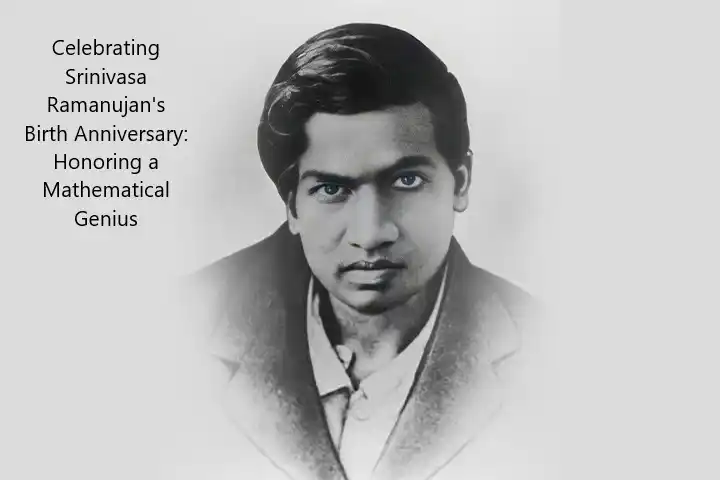Srinivasa Ramanujan, a name that resonates with mathematical brilliance, was born on December 22, 1887, in Erode, Tamil Nadu, India. His contributions to the world of mathematics are nothing short of legendary, and his work continues to shape the discipline even today. Ramanujan was largely self-taught, developing a unique approach to solving complex mathematical problems. His ideas, theories, and theorems were groundbreaking, many of which were ahead of their time.
On his birth anniversary, December 22nd, the world celebrates his immense contribution to mathematics. This day is particularly significant in India, where it is observed as National Mathematics Day. The celebrations not only commemorate Ramanujan’s genius but also encourage students to explore the world of mathematics. Through this article, we explore the importance of this day, highlight key details of his life and work, and inspire readers to appreciate the legacy of one of the greatest mathematicians the world has ever known.
Key Details
| Aspect | Details |
|---|---|
| Full Name | Srinivasa Iyengar Ramanujan |
| Date of Birth | December 22, 1887 |
| Place of Birth | Erode, Tamil Nadu, India |
| Famous For | Contributions to number theory, partition theory, and continued fractions. |
| Academic Affiliations | Cambridge University (collaboration with G.H. Hardy) |
| Death | April 26, 1920 (aged 32) |
| Key Theorems | Ramanujan-Hardy number (1729), Ramanujan’s conjecture, and mock theta functions |
Ramanujan’s Time in Cambridge
One of the most significant chapters of Ramanujan’s life began when he sent a letter filled with his mathematical findings to G.H. Hardy, a prominent British mathematician at Cambridge University. Hardy, initially skeptical, quickly recognized Ramanujan’s genius and invited him to Cambridge in 1914. Despite facing cultural and climatic challenges in England, Ramanujan collaborated with Hardy, producing some of his most famous work, including theories on infinite series, modular forms, and mock theta functions.
Ramanujan’s time in Cambridge was both productive and difficult. Although Hardy’s support helped Ramanujan refine his ideas, Ramanujan’s health began to decline due to the harsh English weather and his struggle with isolation. Nevertheless, this collaboration led to the publication of several pivotal mathematical papers that have remained essential to the field.
Honoring Ramanujan’s Legacy
Ramanujan’s birthday is celebrated not just as a tribute to his extraordinary mind but also as a day to highlight the importance of mathematics in education and society. In India, his birth anniversary is marked as National Mathematics Day—a day to inspire students and educators to embrace the beauty of mathematics. Schools and institutions across the country organize events, lectures, and competitions to encourage the next generation of mathematicians.
In 2012, the Indian government declared 2012-2022 as the “Decade of Mathematics” to honor Ramanujan’s legacy and encourage students to take up the study of mathematics. Statues of Ramanujan can be found at institutions such as the Indian Institute of Technology (IIT) in Chennai, and his work continues to inspire research in number theory, algebraic geometry, and beyond.
Interesting Facts About Ramanujan
- Self-Taught Genius: Ramanujan never received formal training in mathematics but developed his theories independently, often relying on intuition and deep insight.
- The 1729 Number: Known as the “Hardy-Ramanujan Number,” 1729 is the smallest number that can be expressed as the sum of two cubes in two distinct ways. This famous number arose from a conversation between Ramanujan and mathematician G.H. Hardy.
- Rich Mathematical Legacy: Ramanujan’s work on infinite series, partitions, and q-series continues to inspire modern mathematical research. His contributions have influenced areas like algebraic geometry and computer science.
- Health Struggles: Despite his remarkable intellect, Ramanujan suffered from chronic health issues, and his time in England was marked by frequent illness. He returned to India in 1919 due to his deteriorating health.
- Posthumous Recognition: After his death at the age of 32, Ramanujan’s work continued to gain recognition, and his theorems were proven to be groundbreaking in many mathematical fields.
Quotes and Messages
- “An equation for me has no meaning unless it expresses a thought of God.” — Srinivasa Ramanujan
- “The highest form of pure thought is in mathematics.” — Srinivasa Ramanujan
- “Mathematics is the music of reason.” — James Joseph Sylvester
Conclusion
Srinivasa Ramanujan’s birth anniversary is a celebration of the power of human curiosity, intellect, and the pursuit of knowledge. His life serves as an inspiration for anyone passionate about mathematics or any field of study. As we honor this day, it is a reminder of how one individual’s work can change the world in profound ways.
We encourage you to explore more about Ramanujan’s life and theories by browsing related content on our site. Join our WhatsApp Channel to stay updated with interesting mathematical facts, events, and more. What’s your favorite fact about Ramanujan? Let us know in the comments below!





























